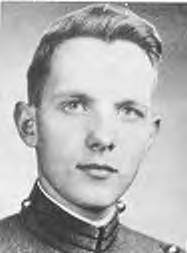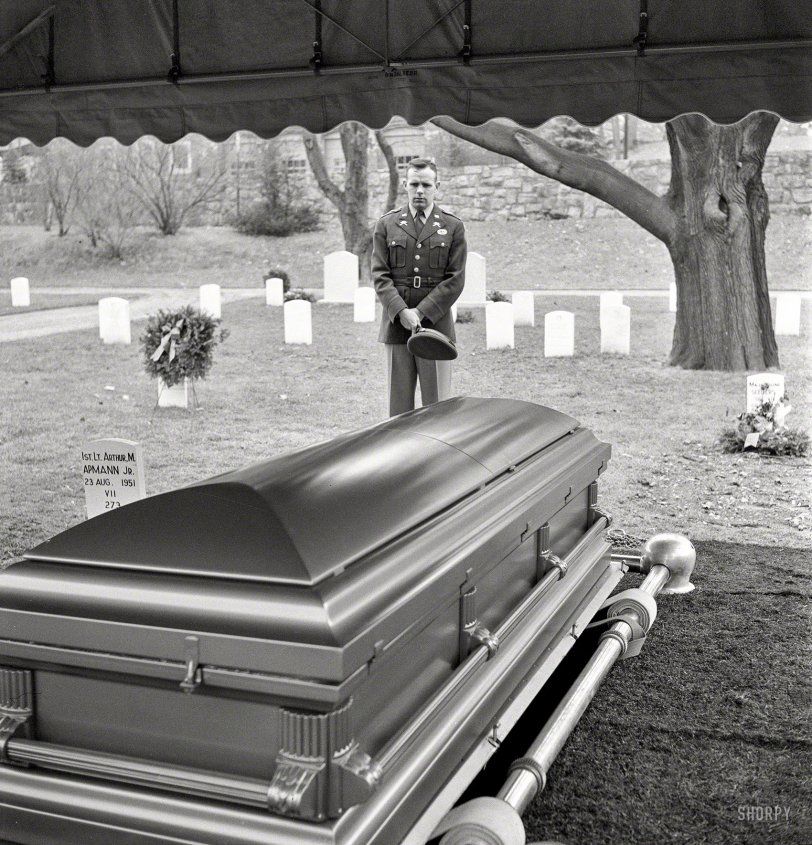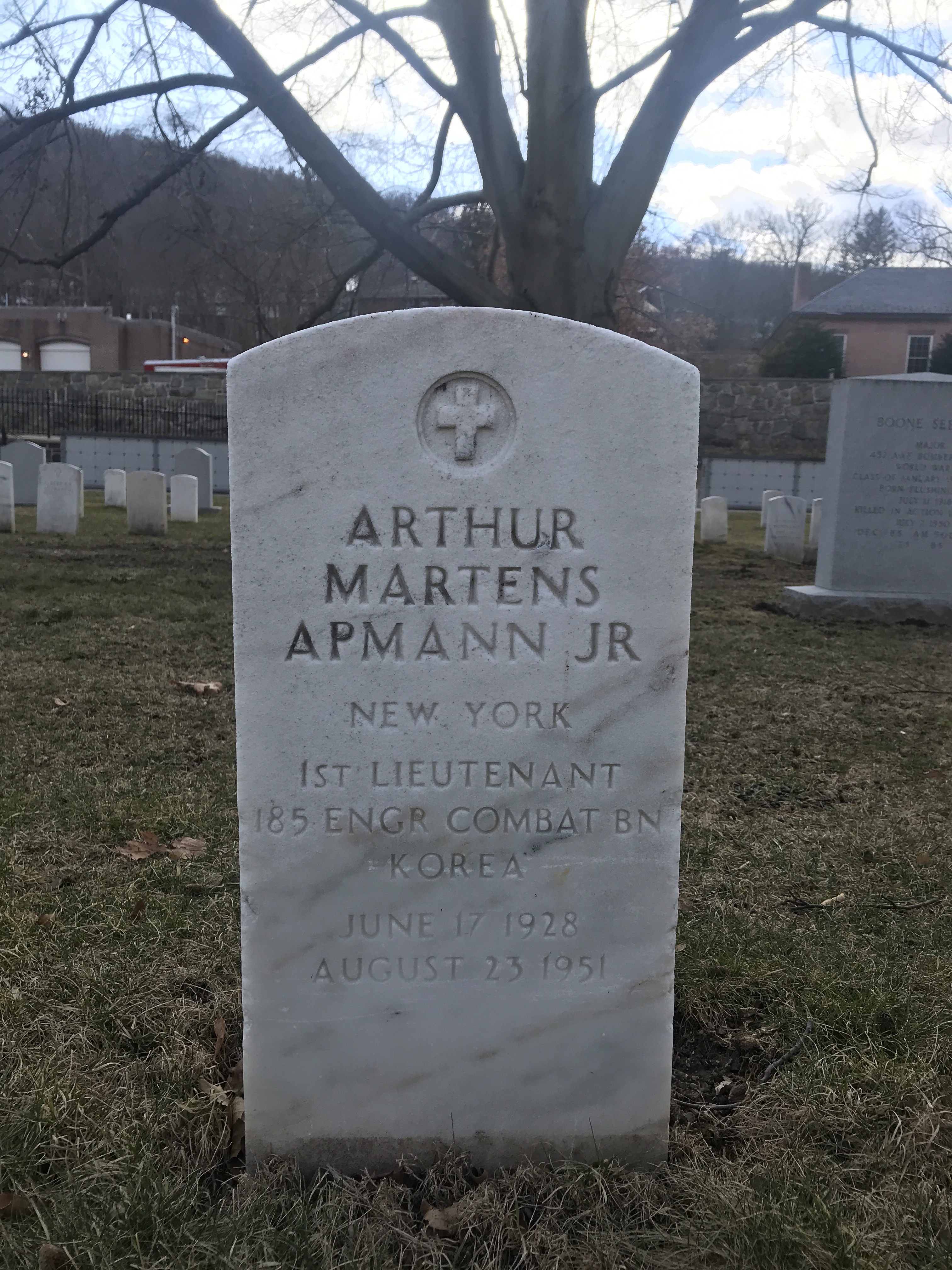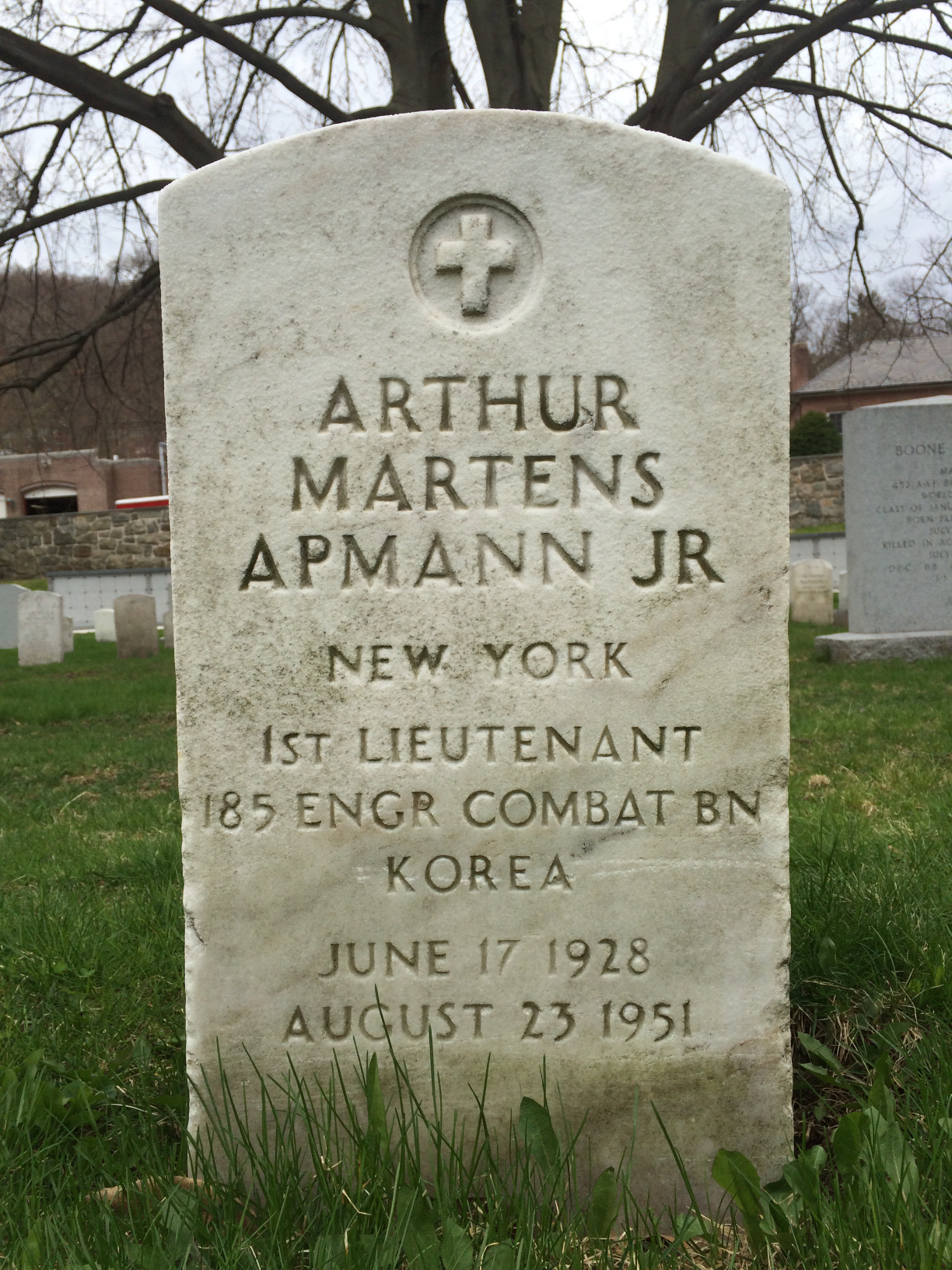NO. 17505 • 17 June 1928 – 23 August 1951
Died 23 August 1951 in Korea, aged 23 years
Interment: West Point Cemetery, West Point, New York
ARTHUR MARTENS APMANN was born in Mt. Kisco, New York on 17 June 1928 to Margaret and Arthur Apmann. His father was a colonel, USAR, serving in the Corps of Engineers. Art graduated from Mercersburg Academy, Mercersburg, Pennsylvania in 1945 and attended Yale for a year before being appointed to West Point from Connecticut by Senator Hart.
Early in his Plebe Year, Art set out to become editor of the Howitzer. A roommate attested that he spent more time at the Howitzer office than in his own room. In furthering his goal he was a member of the Photography Club for four years, used his camera frequently, and was the photographic editor of Fall Out during Plebe Year.
He loved the outdoors and joined the Fishing Club along with six other classmates in order to camp out on the reservation on weekends. Little, if any, fishing was done. It was the enjoyment of the outdoors and the comradeship that interested him. His antics livened up the outings. To escape the gloom period, they camped out in below‑zero weather along the shore of frozen Lake Popolopen one weekend in January. That experience was cold‑weather survival training for Art and several others, and stood them in good stead during the winter of 1950 in Korea, a place they had not heard of yet.
As he had hoped, his cadet days culminated in his selection as the editor of the 1950 Howitzer. The splendid job he did coordinating the various aspects of the book and in developing a closely‑knit, efficient organization resulted in an outstanding yearbook. There was promise for a successful and fulfilling career ahead of him.
Upon graduation, Art chose the Corps of Engineers and received orders to report to Camp Stoneman, California, for shipment to the Far East Command. A company mate with similar orders agreed to meet Art in Chicago and drive his new car to the West Coast where he would sell it. They took a week to drive to California, visiting Art's family and friends in Denver, sightseeing and nightclubbing. Arriving at Camp Stoneman two days early, the company mate had a car to sell and wanted to see San Francisco. But, North Korea had attacked South Korea on 25 June during graduation leave, and Art wanted to sign in immediately and join his new organization. He signed in on 15 August and flew out that night to Japan. It was like him to eagerly answer the call to duty.
At Camp Drake he was assigned to the 185th Engineer Combat Battalion, a Xth United States Army Corps unit, then assembling at Camp Zama. As a new Engineer combat platoon leader, Art helped in loading the battalion's equipment onto sea‑going craft and departed for the Inchon amphibious landing with his unit, supporting the 1st Marine Division and the 7th Infantry Division.
The collapse of the North Korean Army, following the Inchon landing, set the stage for a series of rapid unit moves. Through these early months of the war, Art was leading his platoon in building and repairing the roads and bridges of the supply routes to the two divisions. It was a dirty, dusty, nerve‑jarring and monotonous task he accomplished with stoic cheerfulness that overlaid a determined and ambitious spirit
Regrouping in Pusan, the Xth Corps embarked for another amphibious landing near Iwon, North Korea to envelope die eastern flank of the North Korean Army. The landing in the late fall of 1950 was accomplished with the two US divisions racing to the Yalu River, the 185th close by. However, the entry of the Chinese Army into the way altered plans dramatically.
Under the steady force of the numerically superior Chinese Communist Army, the Xth Corps executed a retrograde operation and debarked successfully at Hungnam.
Hence, Art was soon back in South Korea with his engineer platoon, maintaining the main supply routes on the east coast. The mountainous terrain, steep‑sided river valleys and the rainy season made such work an engineering challenge which he relished, particularly since his promotion to first lieutenant now signified his nearly seven months of continual combat Engineer experience.
Art's demeanor was always inquisitive, cooperative and professional. He went the extra mile to do the job right or to help. On 23 August 1951, a day during the rainy season, he and the battalion commander stood on the bank of a rainswollen river watching the build‑up of debris around the floats of an M2 floating treadway bridge.
The water pressure against the debris was becoming a threat to the stability of the floating bridge. Art went out onto the precarious bridge, crawled to the edge of the pontoon and plunged his bayonet into the fabric, intending to deflate it in order to open a freeway for the debris to pass. Unfortunately, with the loss of structural support from the collapsed pontoon, the wooden saddle assembly also collapsed, tossing Art into the torrent. His body was recovered and returned to West Point for burial in the cemetery.
Art Apmann's youthful, unfearful willingness and diligence have been inspirational. One remembers his passing with sadness yet with the pride of having been his classmate and fellow soldier. Like so many young men, he had so little time, yet like so few, he did the most with the time he had.
- Bill Howe, Lloyd Mielenz, George Lear
NO. 17505 • 17 June 1928 – 23 August 1951
Died 23 August 1951 in Korea, aged 23 years
Interment: West Point Cemetery, West Point, New York
ARTHUR MARTENS APMANN was born in Mt. Kisco, New York on 17 June 1928 to Margaret and Arthur Apmann. His father was a colonel, USAR, serving in the Corps of Engineers. Art graduated from Mercersburg Academy, Mercersburg, Pennsylvania in 1945 and attended Yale for a year before being appointed to West Point from Connecticut by Senator Hart.
Early in his Plebe Year, Art set out to become editor of the Howitzer. A roommate attested that he spent more time at the Howitzer office than in his own room. In furthering his goal he was a member of the Photography Club for four years, used his camera frequently, and was the photographic editor of Fall Out during Plebe Year.
He loved the outdoors and joined the Fishing Club along with six other classmates in order to camp out on the reservation on weekends. Little, if any, fishing was done. It was the enjoyment of the outdoors and the comradeship that interested him. His antics livened up the outings. To escape the gloom period, they camped out in below‑zero weather along the shore of frozen Lake Popolopen one weekend in January. That experience was cold‑weather survival training for Art and several others, and stood them in good stead during the winter of 1950 in Korea, a place they had not heard of yet.
As he had hoped, his cadet days culminated in his selection as the editor of the 1950 Howitzer. The splendid job he did coordinating the various aspects of the book and in developing a closely‑knit, efficient organization resulted in an outstanding yearbook. There was promise for a successful and fulfilling career ahead of him.
Upon graduation, Art chose the Corps of Engineers and received orders to report to Camp Stoneman, California, for shipment to the Far East Command. A company mate with similar orders agreed to meet Art in Chicago and drive his new car to the West Coast where he would sell it. They took a week to drive to California, visiting Art's family and friends in Denver, sightseeing and nightclubbing. Arriving at Camp Stoneman two days early, the company mate had a car to sell and wanted to see San Francisco. But, North Korea had attacked South Korea on 25 June during graduation leave, and Art wanted to sign in immediately and join his new organization. He signed in on 15 August and flew out that night to Japan. It was like him to eagerly answer the call to duty.
At Camp Drake he was assigned to the 185th Engineer Combat Battalion, a Xth United States Army Corps unit, then assembling at Camp Zama. As a new Engineer combat platoon leader, Art helped in loading the battalion's equipment onto sea‑going craft and departed for the Inchon amphibious landing with his unit, supporting the 1st Marine Division and the 7th Infantry Division.
The collapse of the North Korean Army, following the Inchon landing, set the stage for a series of rapid unit moves. Through these early months of the war, Art was leading his platoon in building and repairing the roads and bridges of the supply routes to the two divisions. It was a dirty, dusty, nerve‑jarring and monotonous task he accomplished with stoic cheerfulness that overlaid a determined and ambitious spirit
Regrouping in Pusan, the Xth Corps embarked for another amphibious landing near Iwon, North Korea to envelope die eastern flank of the North Korean Army. The landing in the late fall of 1950 was accomplished with the two US divisions racing to the Yalu River, the 185th close by. However, the entry of the Chinese Army into the way altered plans dramatically.
Under the steady force of the numerically superior Chinese Communist Army, the Xth Corps executed a retrograde operation and debarked successfully at Hungnam.
Hence, Art was soon back in South Korea with his engineer platoon, maintaining the main supply routes on the east coast. The mountainous terrain, steep‑sided river valleys and the rainy season made such work an engineering challenge which he relished, particularly since his promotion to first lieutenant now signified his nearly seven months of continual combat Engineer experience.
Art's demeanor was always inquisitive, cooperative and professional. He went the extra mile to do the job right or to help. On 23 August 1951, a day during the rainy season, he and the battalion commander stood on the bank of a rainswollen river watching the build‑up of debris around the floats of an M2 floating treadway bridge.
The water pressure against the debris was becoming a threat to the stability of the floating bridge. Art went out onto the precarious bridge, crawled to the edge of the pontoon and plunged his bayonet into the fabric, intending to deflate it in order to open a freeway for the debris to pass. Unfortunately, with the loss of structural support from the collapsed pontoon, the wooden saddle assembly also collapsed, tossing Art into the torrent. His body was recovered and returned to West Point for burial in the cemetery.
Art Apmann's youthful, unfearful willingness and diligence have been inspirational. One remembers his passing with sadness yet with the pride of having been his classmate and fellow soldier. Like so many young men, he had so little time, yet like so few, he did the most with the time he had.
- Bill Howe, Lloyd Mielenz, George Lear
Inscription
NEW YORK
1ST LIEUTENANT
185 ENGR COMBAT BN
KOREA
Family Members
Sponsored by Ancestry
Advertisement
Explore more
Sponsored by Ancestry
Advertisement








